SLM Mike Fantasia and team help peel back the layers of time to recount a murderous chapter in Oklahoma history in director Martin Scorsese’s film
by Shaun O’Banion
All images courtesy Apple Original Films except as noted
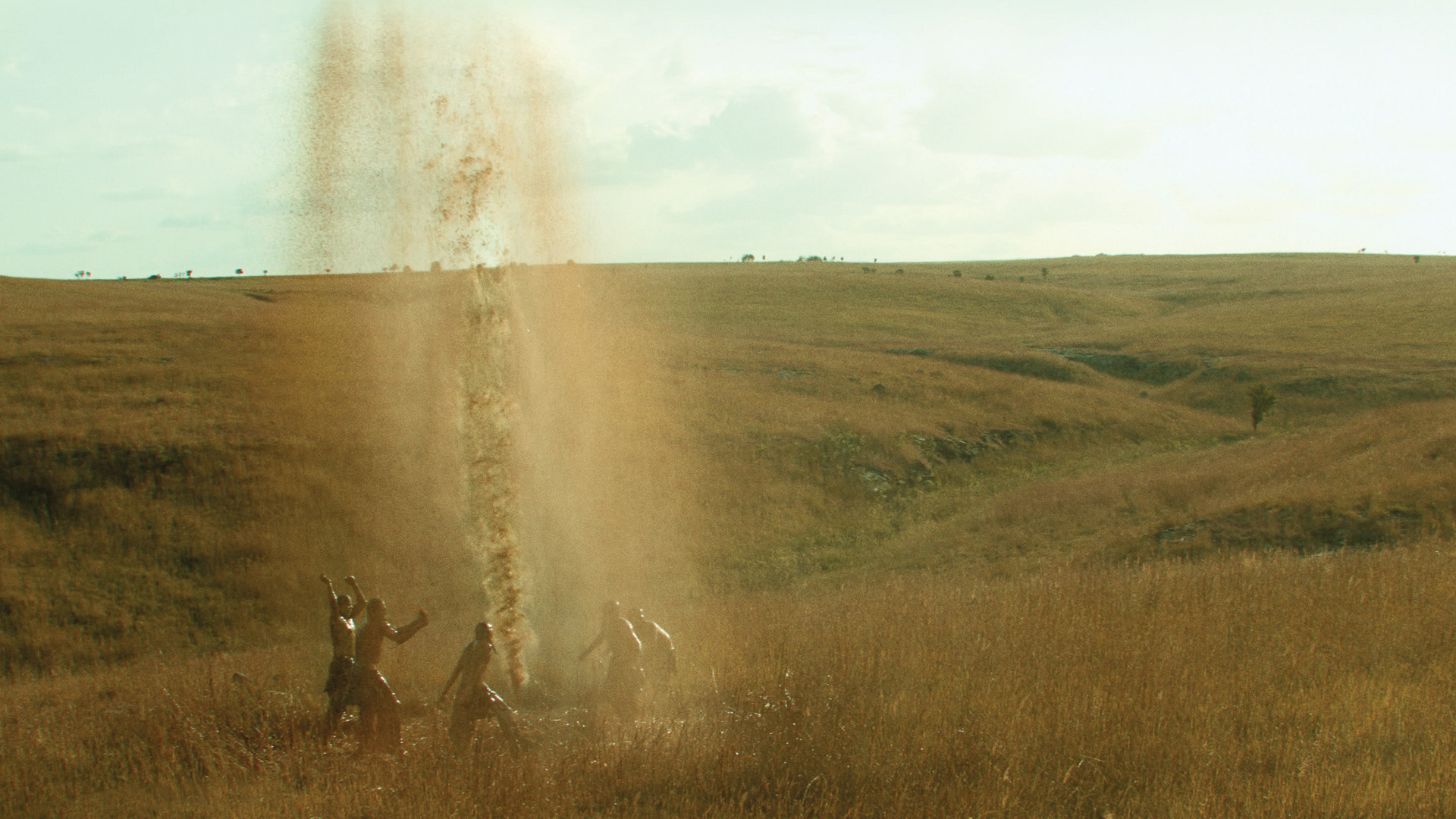 Scorsese adapted the screenplay for this long-awaited movie with fellow Oscar winner Eric Roth from David Grann’s no. 1 New York Times bestselling nonfiction book, Killers of the Flower Moon: The Osage Murders and the Birth of the FBI.
Scorsese adapted the screenplay for this long-awaited movie with fellow Oscar winner Eric Roth from David Grann’s no. 1 New York Times bestselling nonfiction book, Killers of the Flower Moon: The Osage Murders and the Birth of the FBI.
Scorsese worked closely with the Osage Nation to faithfully render details of the period and the portrayal of tribal members. Meticulous attention was paid to tradition, sets, costuming and of course, the setting: the oil fields, towns and grasslands of Oklahoma over a century ago.
MIKE FANTASIA/LMGI GETS THE CALL…
It was June of 2019 and SLM Mike Fantasia (pronounced ‘Fanta-See-uh’) was standing on the set of what he thought was going to be his last film: Top Gun: Maverick. Next to him, director Joseph Kosinski, producer/star Tom Cruise and writer/producer Christopher McQuarrie were talking about where they hoped to put a Technocrane in the middle of a protected wooded area (LMGI Compass, Summer 2022).
Mike’s phone was vibrating and he took a moment to check the caller ID. The number that came up belonged to producer Georgia Kacandes. The two had worked together before and she’d spoken with him a month or two earlier about working on her next film. With Martin Scorsese. She’d been trying to reach him for days. He meant to call back, but never had a moment to spare.
Had he told her he planned to retire after Maverick? That he and his wife were planning to leave their home in Mar Vista, CA, for the clean air and open skies of Montana? No matter. He couldn’t answer now anyway. He was busy.
Kacandes and producer Emma Tillinger Koskoff called again in July of 2019 and he finally picked up. Georgia got right to it. “We’d just said, ‘hello,’ and Emma goes, ‘we’ll give you whatever you want, we’ll give you whoever you want, we’ll leave you alone, you’ve gotta come do this movie,” Fantasia recalls.
The movie was Killers of the Flower Moon.
“I spoke with my wife and she said, ‘How do you say no to Martin Scorsese?’”
Seems retirement would have to wait. Again.
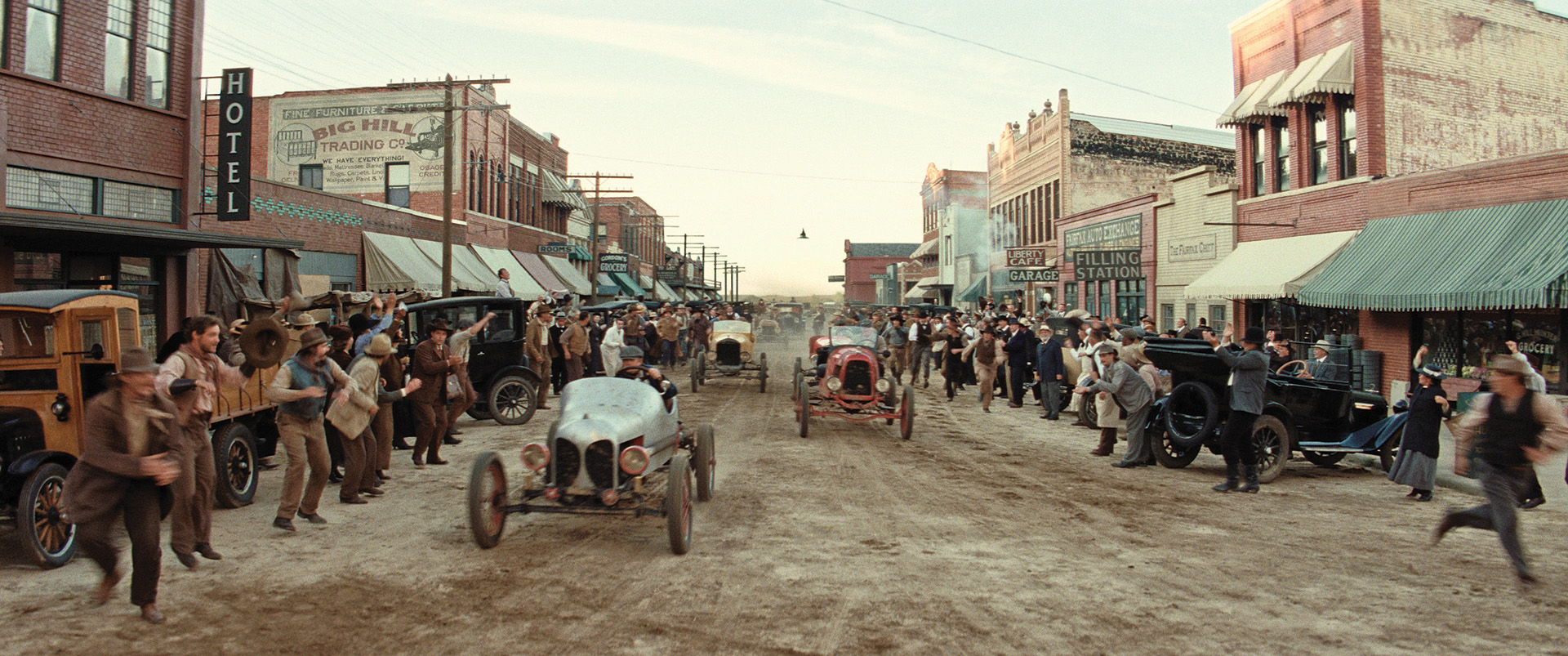
Kihekah Avenue, Pawhuska
TELLING A HORRIFIC STORY FROM OKLAHOMA’S PAST
The story recounts a dark chapter in tribal and U.S. history that revolves around the Osage striking oil on land the tribe had been relocated to from Kansas in the late 1800s because it had been deemed a barren wasteland.
The tribe’s sudden and extreme wealth attracted predatory outsiders who would stop at nothing to get their hands on the money.
A love story between Mollie, an Osage woman (played by Lily Gladstone, a member of the Blackfoot Confederacy of Montana) and Ernest Burkhart, a white man just home from the war, is upended when her family is targeted in a scheme to secure its wealth. Leonardo DiCaprio was producing and set to play the intrepid FBI agent dispatched from DC to investigate a mounting series of mysterious and unsolved murders on the Reservation, with Robert De Niro attached to play William ‘King’ Hale, the local political boss and Ernest’s uncle.
 OKLAHOMA AND THE OSAGE NATION
OKLAHOMA AND THE OSAGE NATION
“This is a story about a monumental period in Osage history and for the state of Oklahoma as well,” says Yousef Kazemi, the Outreach and Production Manager for the Oklahoma Film + Music Office. “It was important that the producers be made aware that the Osage were here and that they were open and interested in being collaborative. But more than that, there was a need to communicate that we believed this story needed to be told in the place where it happened.”
Osage Nation member Chad Renfro was appointed by Principal Chief of the Osage Nation, Geoffrey Standing Bear, to be the tribe’s ambassador for the film.
“The truth,” Renfro says, “is that once Marty and the other producers started conversations with the Osage, and once they came here to see what we had to offer, it became very clear very quickly that the movie simply couldn’t be made anywhere else.”
“The movie was offered huge incentives to film elsewhere,” says Fantasia. “But Oklahoma was where the story happened, and this is where the story was to be told.”
“To be able to tell this story on the land where these events took place is incredibly important and critical to allowing us to portray an accurate depiction of the time and people,” confirmed Scorsese in a 2021 statement.
“When Martin Scorsese wants to make a movie, what matters most is authenticity. He met with Osage tribal leaders to assure them he was there to tell their story.”
–SLM MIKE FANTASIA
SCOUTING
Fantasia pulled his team together quickly, enlisting, among others, LMGI members Donny Martino, Mike Reft, Chris Kucharski and Andrea Keener. Eventually, the department would grow to 14, along with 20 full-time PAs and cultural historian Addie Roanhorse.
They scouted through December of 2019 with Scorsese traveling to Osage County several times to see locations with then production designer Dante Ferretti.
While most of the actual events in the story took place in the town of Fairfax, the filmmakers settled on Pawhuska, the county seat of Osage County, to play for downtown Fairfax in the 1920s. Established in 1872 when the Osage Tribal government opened offices there, it was named after the Osage Chief Paw-Hiu-Skah, which means “white hair” in English.
Pawhuska came of age precisely when the story takes place. Rolls-Royce opened its first dealership west of the Mississippi River there and the no. 1 customer of Tiffany’s at the time was the Osage Nation, whose members would hand out place settings from the New York retailer as gifts. The Pawhuska Historic Downtown District consists of 101 buildings and structures constructed from 1906 to 1930.
Just prior to the 2019 holiday break, the team began to narrow down the possibilities in Pawhuska, “At that point, I’d say we had, probably, 50% of our locations locked in,” Mike recalls.
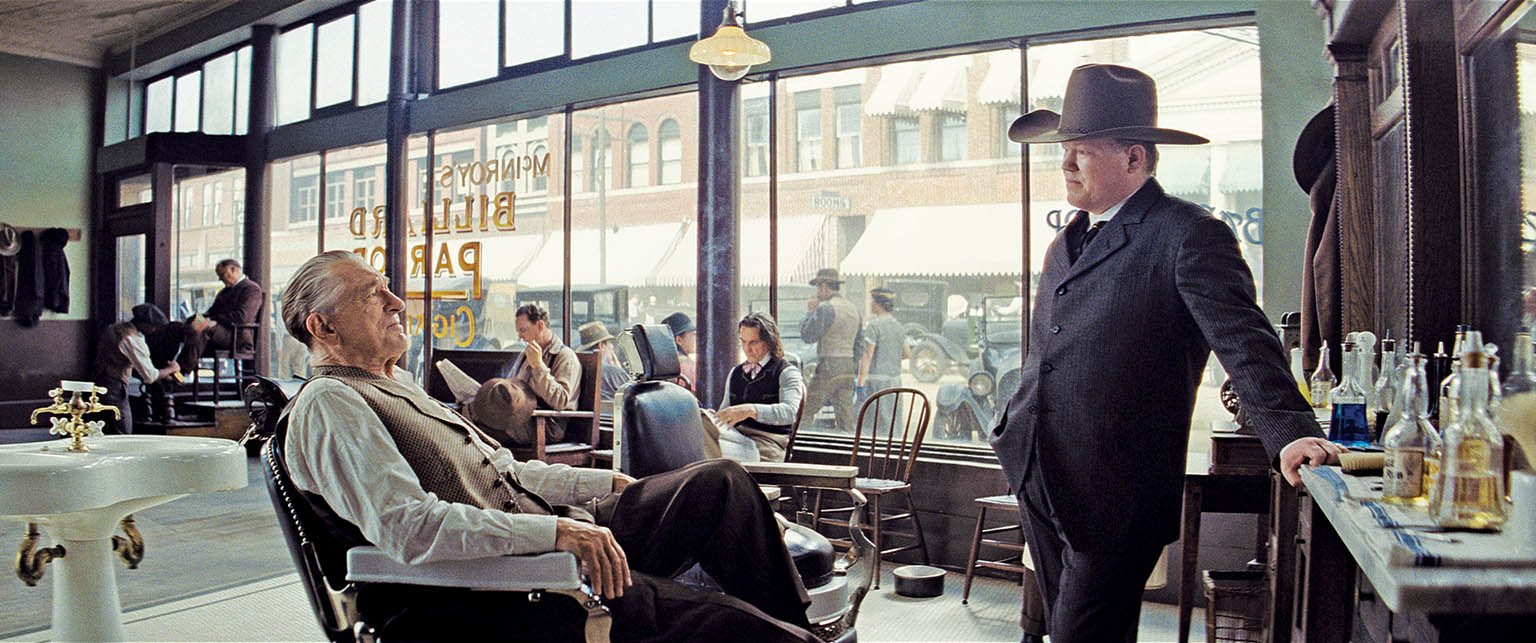 Pawhuska Paused
Pawhuska Paused
Everyone headed home believing they’d be back in January but, over the holiday, Fantasia got a call from the producers and was told the project would be going dark for a rewrite.
It seems that, in working with members of the Osage community, including Chief Standing Bear, Renfro and cultural historian Addie Roanhorse (whose grandfather is one of the supporting characters depicted in the film), Scorsese and Roth decided they needed to rethink their approach to the story.
“For one thing,” explained Scorsese following a screening at the Cannes Film Festival, “the book is basically a procedural, and we’ve seen those before. So how do you do something new with that? Also, the question wasn’t ‘who did it?’ But ‘who didn’t do it?’ since there were so many people involved in these horrific events.”
This decision to rewrite was solidified when DiCaprio asked Scorsese where the heart of the film was. “When he asked, I knew the answer immediately,” Scorsese said. “The heart of the film was in the relationship between Mollie and Ernest Burkhart.”
According to Scorsese, DiCaprio replied, “Well, maybe I ought to be playing Ernest then.” And that was that.
Fantasia was told they would all reconvene in April, but he didn’t believe it. “Lost in ‘development hell,’” he thought. Then COVID-19 spread across the planet and countries all around the world went into full lockdown.
“At that point, I thought the project was done for sure,” he says. But the film industry was one of the first to find a way to get back to work during the pandemic and, sure enough, on April 1 of 2020, the phone rang again.
“I picked up and they said, ‘we’re going back to work,’ I couldn’t believe it!”
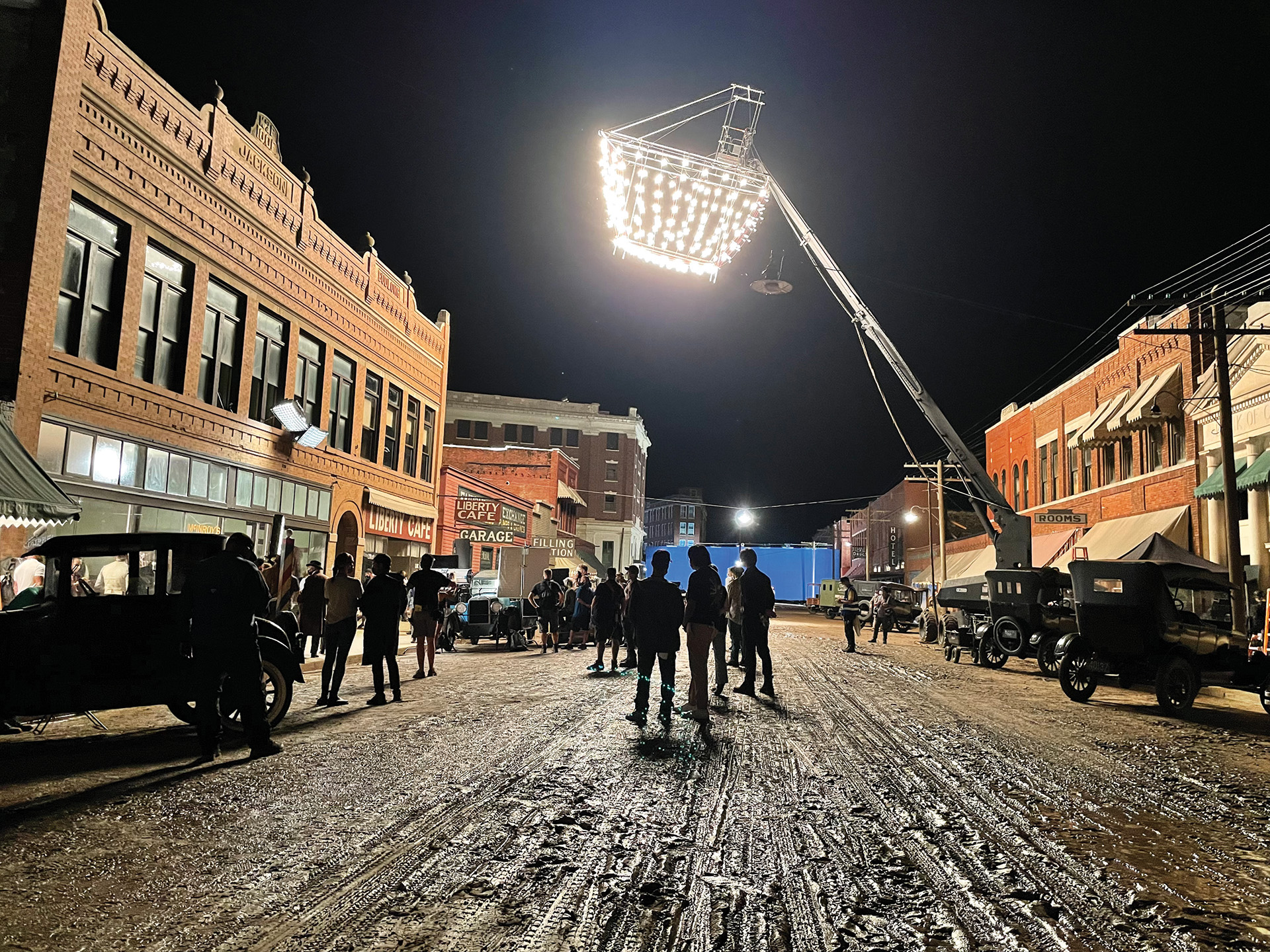
Photo by Mike Walton
STARTING OVER WITH A NEW PERSPECTIVE
I got the new script and it was totally different,” relates Fantasia. “It went from being a ‘white savior’ movie with the FBI on page one, to the movie that we have now, where we don’t get to the FBI stuff until page 60-something.”
DiCaprio had officially moved into the role of Mollie’s husband Ernest, and Jesse Plemons would now take on the role of FBI agent Tom White.
Once the company was back up, they were still at the height of COVID, so the team was working remotely at first, and then within strict protocols. They were also now working for Apple as opposed to Paramount and much of the crew changed along with the studio. Tillinger Koskoff, Kacandes and Ferretti left the project and Daniel Lupi, a veteran of films with Steven Spielberg and Paul Thomas Anderson, joined with production designer Jack Fisk and his art department team.
According to art director Matt Gatlin, when production designer Jack Fisk and his team came onto the project, “the movie was completely re-conceptualized and there was a shift away from an interpretation of the history to more of a recreation of the real places.”
And so, the location department basically started over—with the exception that Pawhuska would still be a stand-in for Fairfax.
Kucharski and Martino did not return; Reft and Keener stayed on; Miranda Carnesalle/LMGI and George Alvarezzo/LMGI joined the team.
FINDING THE TALL GRASS
Carnesalle was on her own much of the time searching for cinematic vistas for driving sequences, beauty shots of nature and plates.
“You’d go out,” she says, “and you’d stop because you’d be looking at this stunning tall grass waving in the wind and you’d think, ‘God, this is just beautiful, but when you’d look through the camera, it would just kind of look like … nothing. It was a challenge to find a location where there would be enough visual interest … something to suggest scale and texture.”
Her photographs intrigued director of photography Rodrigo Prieto, and the two forged a close friendship.
“Rodrigo saw the artist in her,” says Fantasia. “She’d shoot various places for a moonrise or a sunrise and then she’d come back and I’d just say, ‘go right to Rodrigo. If he’s happy, I’m happy.’”
“Scorsese completely relies on and trusts his team to review and vet locations before they ever come across his desk,” says Carnesalle. “So, I’d go shoot and then Rodrigo and I would go through everything. When he found something he liked, that’s when we’d go to Scorsese.”
Many of the locations for these shots were ultimately found on the Joseph H. Williams Tallgrass Prairie Preserve in Osage County, which is the largest protected tract of tallgrass prairie in the world at almost 40,000 acres.
“This was my first experience working with Mike and his team, but they are just, all of them, absolute pros. The sheer number of sets that we were all dealing with was overwhelming and the scale of this project was massive, with things often happening simultaneously in five different locations that were all an hour apart from each other in a remote locale with fewer resources than you would have if you were in a major film hub.”
–ART DIRECTOR MATT GATLIN
KIHEKAH AVENUE
The location in the film seen perhaps more than any other is Kihekah Avenue, the main thoroughfare of Pawhuska. “It didn’t take long to realize we would be able to do a ton of filming on that street,” explains Gatlin. Production would need to own a three-block section of the downtown area that included some 50 businesses, essentially turning it into a backlot.
“At that point, 30% of the storefronts were empty,” says Fantasia. “The rest varied from thriving to barely hanging on.”
Forty-one different entities owned the various properties on the street and the production would need to make arrangements to alter as many as 25 of them for picture. Historian Addie Roanhorse is also co-owner of the Big Rain Gallery, which would become Hale’s Ballet School, as well as a central meeting point for several departments, the location and art departments among them. She even has a small role on screen. Her first meeting with Mike was a memorable one.
“They were here for a scout,” she remembers, “and we always knew whenever they were in town, like, they’d be walking up the street in a big group and people would say, ’there go the movie people.’”
Addie was in her gallery when Mike texted to ask if he could come by with some of the crew.
“I said ‘sure,’” Addie says, “and then this huge group of people comes walking in with Mike to find me just hysterically laughing because, about two seconds after we hung up, my smoke alarm began to chirp really loudly which is not an easy fix when you’ve got 15-foot ceilings. So there I am trying to origami this ladder out of a closet and Mike takes the ladder, quickly climbs up, replaces the battery, comes down and almost with a wink says, ‘I’m pretty handy.’”
Fantasia impressed her immediately and, over the course of the shoot, became a mentor to Addie and other members of the community.
“There was a real trust there,” she says. “People still ask me if Mike’s going to come back to visit … and not just Mike, but Andrea and the other members of the team as well.”

Photo by Cait Murray/LMGI
THE HOLDOUT
The team spent months talking to the other property owners and were able to sign agreements with all but one. The lone holdout was a woman they had been speaking with for six months.
“She couldn’t have been nicer all the way from 2019 up until I sent over our timeline and the bullet points of what the art department wanted to do,” Andrea Keener says, “and all of a sudden, she goes, ‘I have to get my son involved now. He actually owns the building,’ and we were like, ‘wait, what?!’”
The woman’s son, unfortunately, did not want to play ball.
“We sat around her lawyer’s table,” Keener recalls, “Mike, me, the woman and her son and he just said ‘no’ to everything. So out of all those businesses, that was the only one … and it was right in the middle of our run.”
Fortunately, by that time, they had negotiated with the city to completely “own” the street.
“I tried one last time,” Keener says. “I told them, ‘look, you can come aboard, let us affect your building and we’ll pay you, or you can be open when we’re not working but nobody will be able to park in front of your store because we’re going to cover the street in dirt and the road’s going to be closed. You won’t even be able to park in front of your store.”
The owner would not budge, so when it came time to film, the store’s façade was creatively obscured by fruit stands with large canvas backings and 1920’s picture cars.
Keener continued to speak with the woman, who cooperated when she could. “She let us take down this big sign she didn’t like and the art department made her a new one. We wound up doing some other things that helped us and, in the end, probably helped her too.”
Keener still has a voice mail from the woman about what a wonderful experience it was.
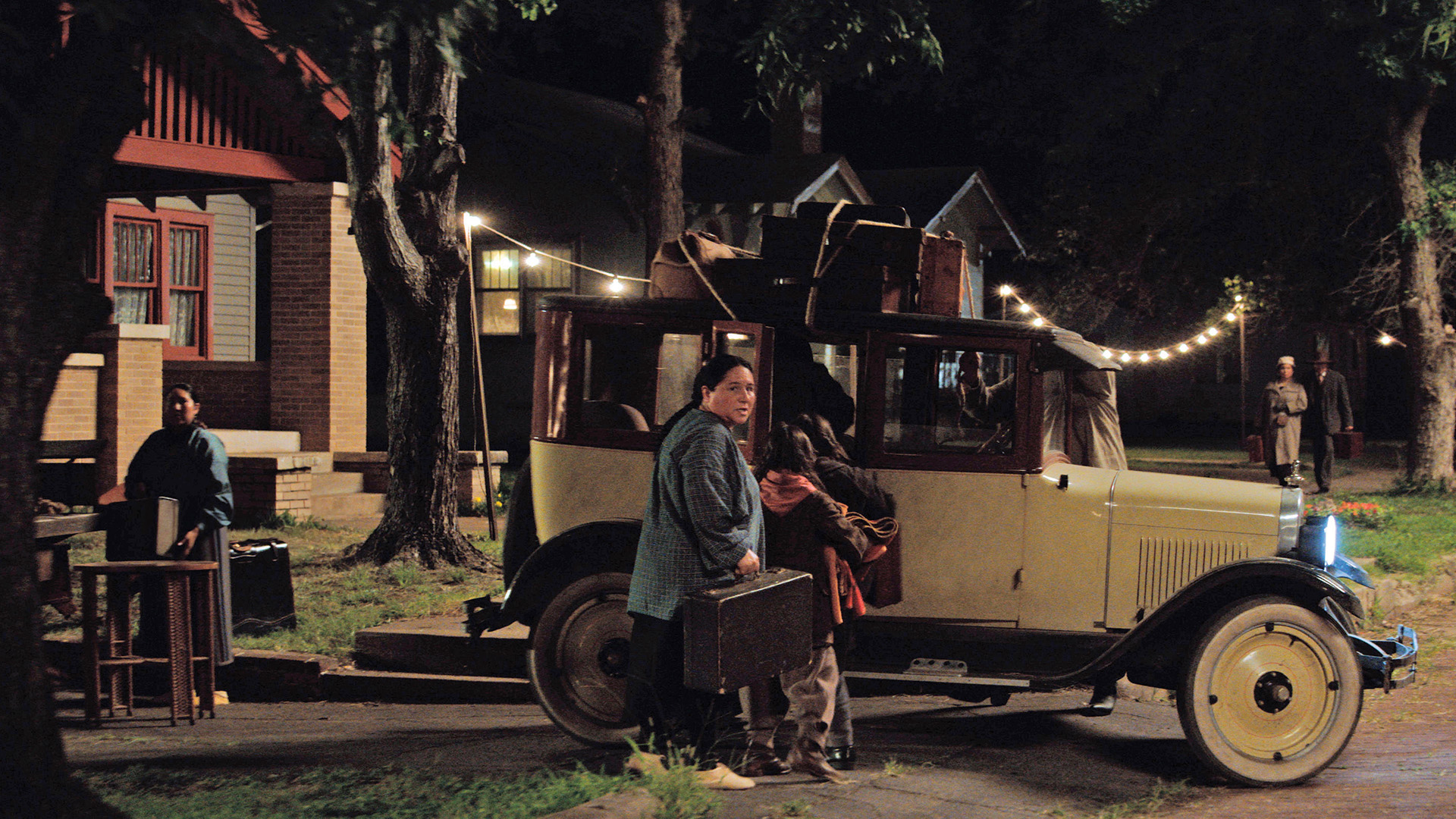 HOMETOWN APPLIANCES: UNMASKED
HOMETOWN APPLIANCES: UNMASKED
While nearly every single property on Kihekah Avenue required work, perhaps none required more than Hometown Appliances, a store which would come to serve as one of the focal points on the street.
Hometown Appliances sells washers, dryers, TVs and other electronics to the community and the owner has owned the building for decades.
At first, what they were asking wasn’t going to be a big deal. But then Fisk decided to combine two different sets into one—the billiard parlor and barbershop—where several critical scenes take place.
It was an idea borne out of a memory Fisk had from growing up in rural Illinois—a memory of his mother taking him to get his hair cut in a pool hall. When the art department later pulled up fire maps from Osage County during the period, they discovered that, of the three pool halls in the area at the time, two had barbershops.
Keener already knew the owner from the first iteration of the film, so when she walked back into the store after being away for months, he was pretty surprised. “I was like, ‘here we are again! We’re really going to do it now,’” says Keener.
The owner was on board, but he really wanted to keep his business open. They’d not only have to find a nearby location large enough to move the entire business to, but then get him to agree to move to that new location—for six months!
“The store really did serve a big purpose for the community, so I totally got it,” she explains. “The closest real store is a full 30 minutes away, so people really did shop local there as much as they could and this man took care of people in the community.”
They eventually found him a new spot and moved every single piece of merchandise out. When the team finally gained access, it proved to be much more of an extraordinary find then they had imagined.
Keener recalls, “There were rats living in there and birds and just… Yeah. Wildlife. It was … an unmasking!”
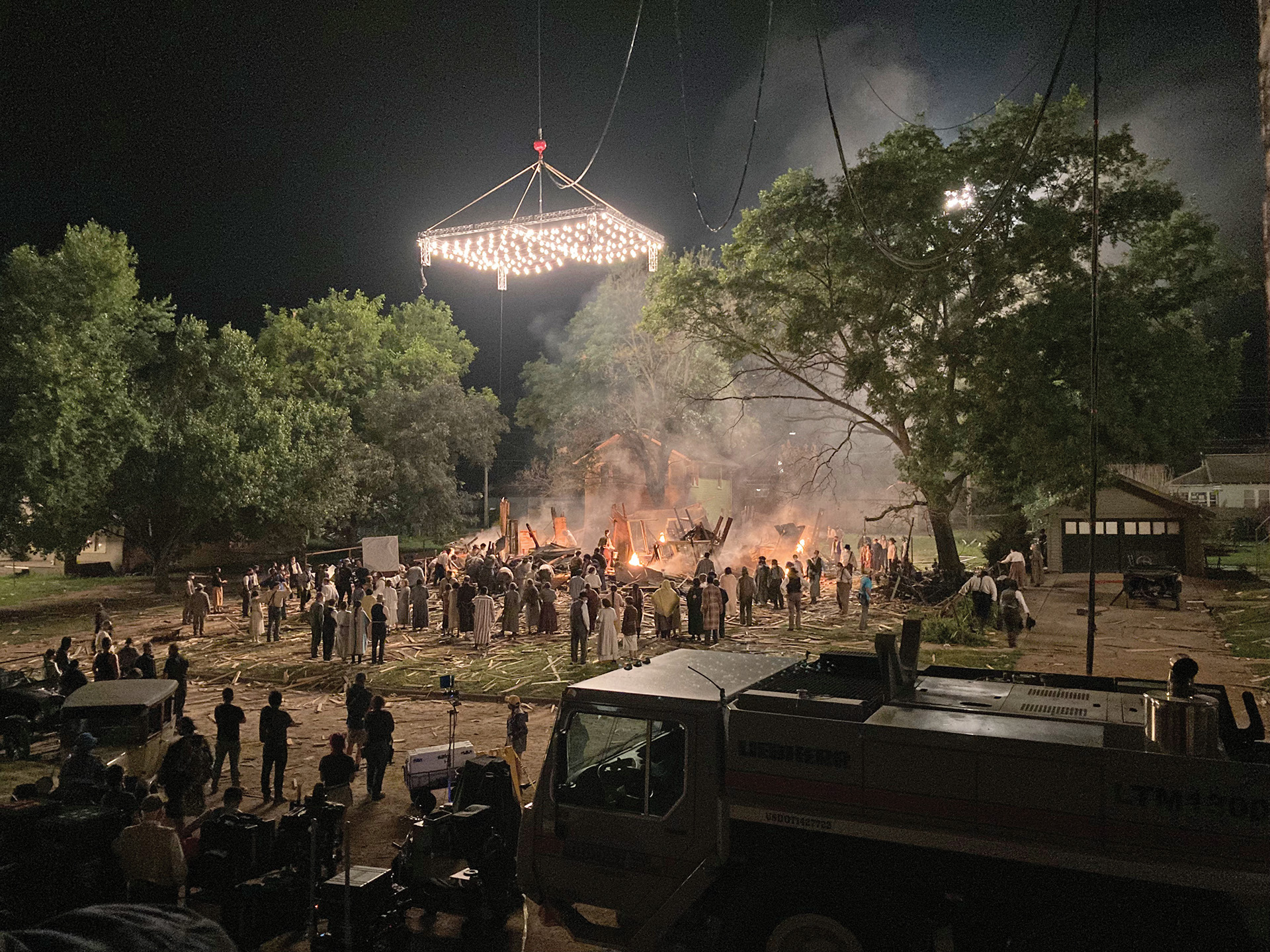 Original pressed tin tiles were revealed after the drop ceiling was removed, and also, says Gatlin, “the full height of the front windows and these absolutely beautiful transom windows above that had layers of plywood and other material covering them from both from the inside and the outside.
Original pressed tin tiles were revealed after the drop ceiling was removed, and also, says Gatlin, “the full height of the front windows and these absolutely beautiful transom windows above that had layers of plywood and other material covering them from both from the inside and the outside.
“So not only had they lost the beautiful period ceiling inside the store, but also the light all those windows bring in. Then, on the exterior, there were these amazing black and yellow four-inch tiles, all along the bottom of the storefront that had also been covered. It was like discovery after incredible discovery in that space.”
In the end, the building got a complete makeover. They uncovered the windows, the original hardwood floor and plastered the walls in an aged-olive green, then filled one half of the room with a dozen 1900’s Brunswick pool tables and, on the barbershop side, installed period-correct half-inch hex tile and a line of chairs and mirrors.
Many of the buildings on Kihekah were also in a state of disrepair and the location team had to create an entire calendar just to track remediation and repair of the various spaces. This process alone stretched to months and months.
“We spent a considerable amount of money on things like mold abatement, remediation and construction. It was just a massive undertaking,” Lupi recalls. “Occasionally, what we did was to trade renovations as payment or at least partial payment.”
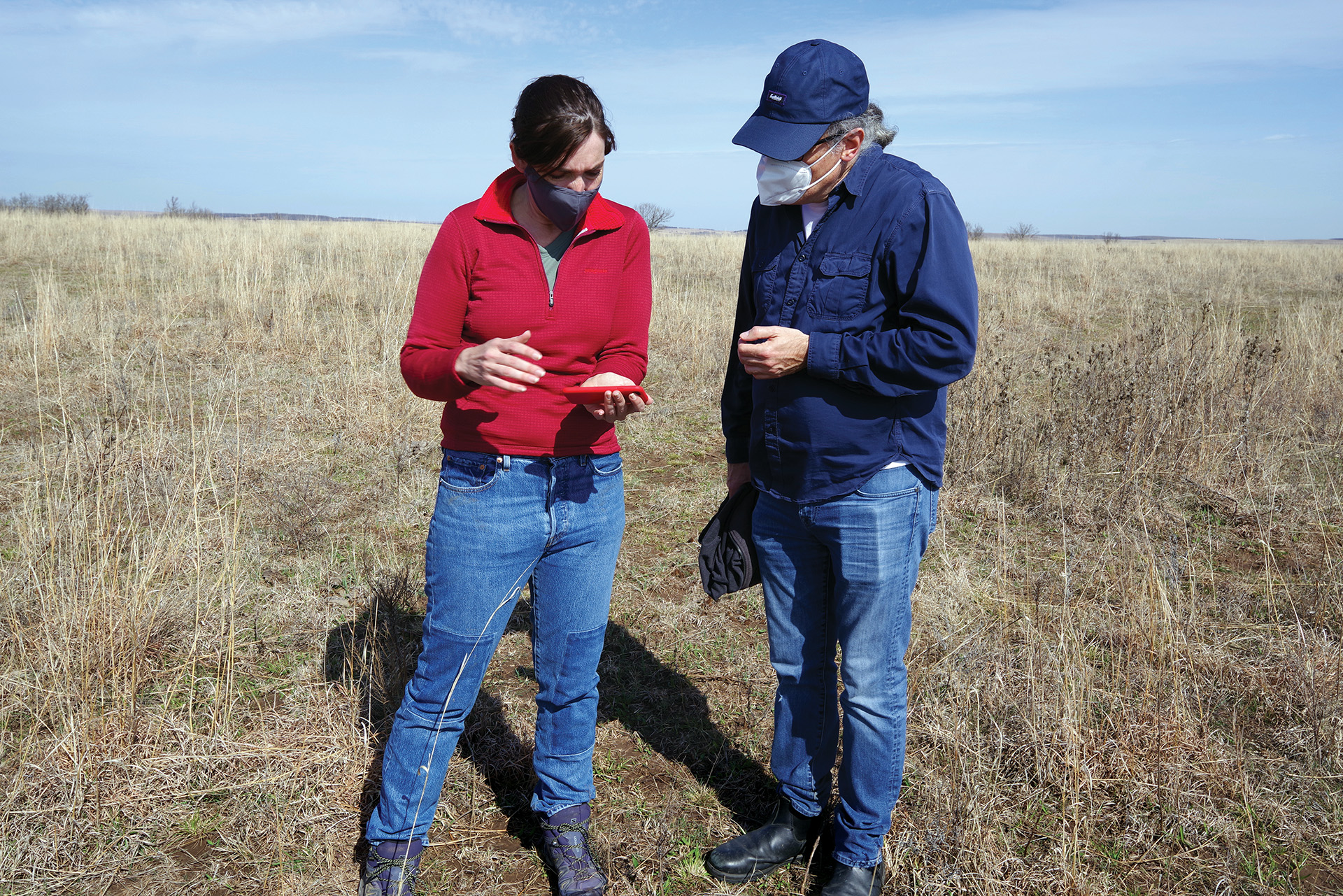
L-R: Miranda Carnessale/LMGI and DP Rodrigo Prieto
SUPPORTING A TOWN
Most of the scenes on Kihekah involved as many as 800 background performers, many of them traveling from Tulsa and further out for a chance to be in the film.
In the last census, Pawhuska’s population was noted at 2,948 people. Between the cast, crew and background, the production grew that population by close to 1,100 more.
The team fixed its sights on an abandoned supermarket with a parking lot large enough to hold tents for background, hair, makeup and costumes. It was owned by a man in New York but Fantasia says, “He wouldn’t rent to us no matter how many times we came back to him!”
They eventually found out that the property owner was in the process of selling to the Nation, who hoped to build a medical center there. The Osage intervened and within a matter of days, permission was granted.
They now had to source a very specific kind of tent.
“You can’t use the same kind you would in L.A. or Atlanta because of tornadoes and inclement weather, so we had to use these huge, heavy, aluminum-frame tents we found from a vendor in Texas,” Fantasia explains. “They were maybe 300 feet long by 200 feet wide. Then we brought in swamp coolers and HVAC to keep the tents cool inside and the air clean because of COVID.”
They got lucky with weather, for the most part, though at one point, a sudden rainstorm nearly washed away all the dirt they’d laid down on the street. Temperatures in Pawhuska through the summer regularly hit 112 degrees or 113 degrees with as much as 95% humidity. And many of the background were dressed in wool, leather or buffalo hide.
Fantasia estimates that production spent well over a million dollars for background support alone in Pawhuska. Combine that with the million and a half dollars of roads they had to build on the various ranches they shot on, roads which then had to be completely removed down to the last stone and the land re-seeded, and you begin to get a sense of how massive the production was and why the budget shot up to an estimated $200 million.
“I’ve built roads before, I’ve built train depots and basecamps, but never to this extent,” Fantasia says.

L-R: Nate Wilson, Mike Reft/LMGI, Brady McIntyre, George Alvarezzo/LMGI
THE NEIGHBORHOOD IN FAIRFAX REVISITED
While the first team of producers had nixed filming in Fairfax, the new team, spurred on by Fisk, eventually agreed to shoot a number of locations there. George Alvarezzo and Mike Reft would handle the majority of them, including the residential street where Mollie and her sister both had their city homes.
It meant not only taking the two hero houses back to their ’20s glory, but many of the neighboring houses as well.
Matt Gatlin recalls, “For some of the houses, there would be a laundry list of modifications we needed to make to bring them back to the period and for others, we wouldn’t have to do all that much.”
Fantasia, Alvarezzo and Reft created a map of each property that Scorsese, Prieto and Fisk could use to mark out precisely what they’d see.
Once we knew what the frame was going be,” Gatlin says, “we’d go to the guys and say for example, ‘we would like permission to paint houses one, five, seven, nine and thirteen,’ or ‘we need to change the windows on houses 10 and 11 and we also need to remove their mailboxes.’”
A major scene required that one of the houses be destroyed in a massive explosion. The actual explosion would be heard off screen, with the sound and reverberations experienced by Mollie in her bedroom down the street.
“It’s nuts when you read the history of it,” Fantasia adds. “They probably could’ve used a pint of nitroglycerin and gotten what they wanted, but they used a gallon and just decimated the house with three people inside.”
The question for production was how could they depict a 1920’s house as a normal, functioning home and then show it post-explosion without the use of CGI?
“I think it was Jack Fisk who originally said, ‘let’s just buy someone’s house and blow it up,’” laughs Lupi, “and I remember saying, ‘what are you talking about?’”
Incredibly, Fantasia found a house where they could do exactly that on North 4th Street.
“We knocked on the door of this house that’s about four blocks from the site where the real house was blown up,” he says, “and it appeared to be abandoned, but we weren’t sure because there was still stuff inside.”
Eventually, they found the homeowner.
“I just kind of laid out for her who we were and what we were trying to do. Then I said, ‘so, we’d like to shoot inside the house and then we’d like to blow it up,’” laughs Fantasia recalling the absurdity of the request.
The woman took a beat and then said, “OK.” I looked at her like, ‘what?! I would’ve bet five weeks’ pay that she was going to say ‘no’ but she didn’t,” Fantasia says, still astonished at this stroke of luck. The house had belonged to her parents and had sat empty for several years. She was willing to let it go.
It was also more than 100 years old which meant it was another property which would require remediation and abatement.
In reality, the house was not actually blown up, but restored and then carefully disassembled to show the smoldering aftermath.
“We went in, stripped everything out and the art department turned the clock back on it to the 1920s,” says Fantasia. “Then we shot a day or two inside, had the remediation company come in, encapsulate it all and then we brought a contractor in and he dismantled the house with the art department literally telling him ‘OK,’ move this chunk of wall over here, ‘or rip up that chunk of the floor and put it over there.’”
When they were done filming, the contractor came back and took everything above ground away. “Then we collapsed the basement, filled it with dirt, graded the land, seeded it and it’s now just a big, empty grass lot between two houses,” he says.
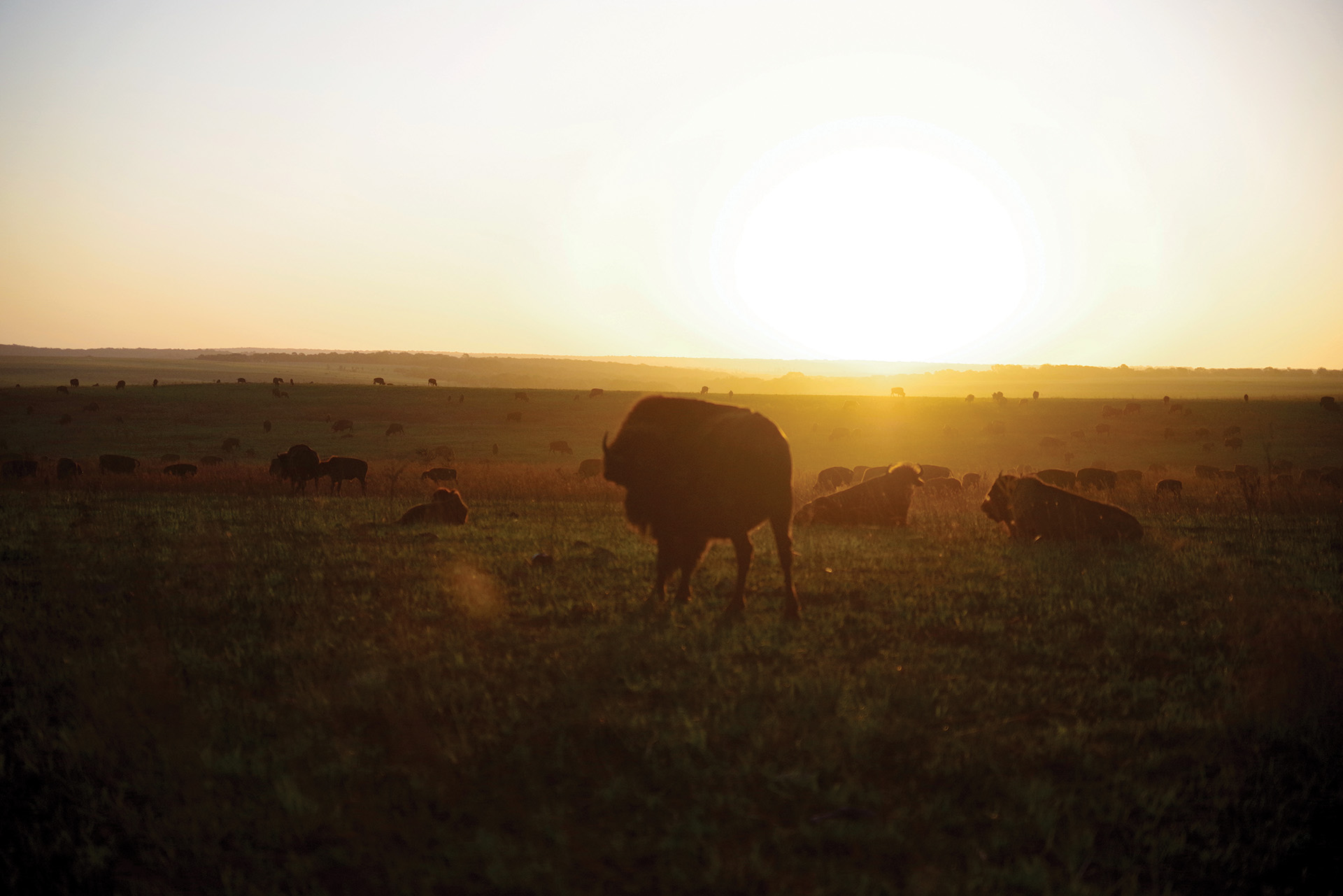
Photo by Miranda Carnessale/LMGI
OF RANCHES AND RAIN (OR LACK THEREOF!)
The location department did similar work at the Hughes Ranch, where the Hale house was erected, and at the Ford Drummond Ranch where Mollie’s country house, the Osage village and cemetery were built.
When filming wrapped, the structures and roads were completely removed, the land was re-seeded and you’d never know they were there. But that wasn’t the end of it. Fantasia was still dealing with one of the properties only several weeks ago as of press time.
“We finally got a release in June of this year from the Ford Drummond property because, after we pulled the gravel and seeded, they didn’t get rain so the grass didn’t grow. You have to understand, the grass is like gold to these guys. It’s what their cattle eat. Native tall grass has higher nutrition than any other type of grass in the country. You learn all kinds of shit when you do a movie,” laughs Fantasia.
No rain meant they needed to seed the ground again. And again, they got no rain. Finally, in the spring of 2023, they tried a different type of the native grass, decided to hydro-seed and then they paid the rancher to water once a week until it took.
Fantasia talked to the rancher in September and was told the grass is finally growing and will be back to normal in a year.
“That was a huge relief because if I had had to fly back to Oklahoma and re-seed the ground myself, I would have because I gave them my word,” he says. “But I have to say that Apple has been amazing. They went beyond the agreement. The agreement terminated in 2022 because everyone assumed the rain would come and the grass would grow … but they just spent a nice six-figure number on the third go-round.”
Gatlin confirms the skill and integrity that Fantasia and team brought to the project. “It requires an enormous team effort, a lot of communication and just kind of supporting each other to figure it all out. Mike and his team were able to tackle pretty much everything we threw at them.”
“Mike is one of those location managers that loves being a location manager,” says Lupi. “And most people don’t understand just how difficult the job is and how a SLM has to carefully ride the line between working for the producers, the shooting company and the people whose properties we’re filming on. And I think riding that line must become very … frustrating. I think Mike was incredibly good at balancing that.
“I’ve known Mike going back to Catch Me if You Can and, what can you say? He’s just a legend in the business and he’s definitely going out on a high note.”

L-R: Mike Walton, Jason Wolf/LMGI, Mike Fantasia/LMGI, Andrea Keener/LMGI
THE LAST HURRAH
Mike Fantasia has some 39 credits going back to Spielberg’s Always in 1989, and what connects them all is that they are all well-regarded movies that have stood the test of time. It’s an incredibly impressive collection of films and filmmakers.
In thinking about Killers of the Flower Moon, Fantasia is proud to have had it serve as his last cinematic hurrah.
“You always want to go out on top and I felt like I had with Top Gun: Maverick, but reading this script, knowing that Martin Scorsese was going to be at the helm… Well, it’s bigger than I could have ever imagined. I feel so lucky to have been a part of it.
“I mean, look, I’ve had the opportunity to work for a lot of great filmmakers and a lot of great studios on a variety of stories, from sci-fi to action to comedies to Westerns and now this. This project and this team are, for me, just … unrivaled. We drew together as a cohesive unit and they all busted their asses, from the PAs to the office coordinators to the assistants on the ground. They made me look really good.”
Killers of the Flower Moon shot for 100 days on 99 different sets in 57 locations and 12 distinct areas of Osage and Tulsa Counties. The film is in theaters now and will be made available to stream on AppleTV+ and other platforms.
KILLERS OF THE FLOWER MOON LOCATION DEPARTMENT
SLM Mike Fantasia/LMGI
KALM Andrea Keener/LMGI
KALM Miranda Carnessale/LMGI
KALM Teddy Alvarez/LMGI
KALM George Alvarezzo/LMGI
KALM Michael Betz/LMGI
KALM Kirsten Cornay/LMGI
KALM Jason Wolf/LMGI
KALM Luke Helms/LMGI
KALM Cait Murray/LMGI
KALM Dylan Brodie/LMGI
KALM Scott Kimbrough
ALM Mike Reft/LMGI
ALM Rachel Trombetta
ALM Mark Walton



